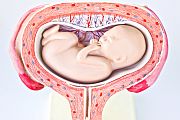No findings of morbidity, injury tied to maneuvers, when adjusting for duration
MONDAY, March 23, 2015 (HealthDay News) — A variety of shoulder dystocia maneuvers are not associated with neonatal morbidity after adjusting for duration, according to a study published in the March issue of the American Journal of Obstetrics & Gynecology.
Janine E. Spain, M.D., from the Washington University School of Medicine in St. Louis, and colleagues retrospectively reviewed all cases (2005 through 2008) in a retrospective cohort study of women who experienced a clinically diagnosed shoulder dystocia at term requiring obstetric maneuvers. A reference group of women delivered by McRoberts/suprapubic pressure only (135 women) was compared to women exposed to Rubin maneuver (83 women), Wood’s screw maneuver (53 women), or delivery of the posterior arm (36 women).
After adjusting for nulliparity and duration of shoulder dystocia, the researchers found that individual maneuvers were not associated with composite morbidity, neonatal injury (clavicular or humeral fracture or brachial plexus injury), or neonatal depression (defined as Apgar <7 at five minutes, arterial cord pH <7.1, continuous positive airway pressure use, intubation, or respiratory distress).
“Our results demonstrate that clinicians should utilize the maneuver most likely to result in successful delivery,” the authors write.
Copyright © 2015 HealthDay. All rights reserved.








